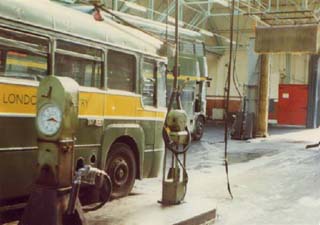 St. Albans has always been an important Hertfordshire market town, with inreasing growth in
electronics and manufacturing in post-war years. Services in the area were operated by a number
of independent operators from the 1920's onwards, taking advantage of the fact that National's
nearest garages were at Watford and Hatfield. All those operators were acquired between
November 1933 and March 1934 by the LPTB mostly through compulsory purchase or refusal of
operating licenses. The largest fleets were those of St.Albans & District and Albanian Omnibus.
St. Albans has always been an important Hertfordshire market town, with inreasing growth in
electronics and manufacturing in post-war years. Services in the area were operated by a number
of independent operators from the 1920's onwards, taking advantage of the fact that National's
nearest garages were at Watford and Hatfield. All those operators were acquired between
November 1933 and March 1934 by the LPTB mostly through compulsory purchase or refusal of
operating licenses. The largest fleets were those of St.Albans & District and Albanian Omnibus.
The LPTB concentrated their new operations on the premises of St.Albans & District in Hatfield
Road, a former drill hall, and Flowers & Etches (City Omnibus Services) in Wynchlands
Cresent, also off Hatfield Road. This building survived until 1986-7 as a warehouse, but has
since been demolished and replaced by a house. Additional space for Greenline operation was
found in Harpenden, where Comfy Coaches had been based.

|
That the old premises were unsatisfactory is no surprise, and new facilities were rapidly developed. During this period
London Transport was a beneficiary of major public works funding as the government tried to kick-start the foundering
British economy. Significant investment had already been been made in the southern operating area with garages being
built by or for the East Surrey company, but no such provision had been made across the northern operating area. Thus,
new garages in the contemporary style developed by Frank Pick and Charles Holden were built at Addlestone, Amersham,
Epping, Hemel Hempstead, Hertford, Northfleet, St.Albans and Windsor between 1934 and 1937.
|

|
In St.Albans the new building, at the North end of St.Peter's Street was opened in 1936. Like several others of the
period, it had an integral bus station. None of the others matched the 'Art-Deco' splendour of its reinforced concrete
canopies, seating and timetable displays. These remained largely intact until the mid-1980s, when London Country,
trying desperately to find space for the growing vehicle allocation, began removing the fixtures and attractive gardens
to make additional parking space and access roads. The job was completed by the City Council, who created a car park
on the forecourt after the garage was vacated. These acts of vandalism spoiled the attempt to obtain listed building
status in recognition of its architectural merit, despite being within a conservation area.
|

|

|
The colour pictures from the collection of Tim Pickford-Jones
(Timmonet)
give a wonderful feeling for the variety of vehicles that could be seen
around SA in the early London Country period. Note the red RT staff bus parked at the back, and the SMW class
Swift in the bus station. Inside the garage note the antiquated fuel and lubrication
equipment, and the RMC coach downgraded to bus duties. At this period the garage had one of the largest allocations of
vehicles, over 60, of types MBS, RF, RMC, RP & SMW. He also has a picture of the new housing on the site, which is
just too painful to display here. Thanks for sharing the pictures, Tim!
From 1992, the St.Albans Transport Heritage Trust battled towards retention of the building and finding a commercial
partner who would occupy part of the site alongside a transport museum housed within the garage buildings. The City
Council were supportive, and for several years there was an annual 'Discover St.Albans Rally' and bus operating event.
Most interesting was a cinema partnership, for which architectural plans and proposals were submitted for planning
approval. However, the high commercial value of the centrally-located site and pre-determination of the City Council
towards residential development finally extinguished any hope of saving the buildings. They were demolished in 1998.
Acknowledgements:
I am pleased to thank the contributors to the St.Albans Project Supporters newsletter (SA-SO) for much of the information
above.
 St. Albans has always been an important Hertfordshire market town, with inreasing growth in
electronics and manufacturing in post-war years. Services in the area were operated by a number
of independent operators from the 1920's onwards, taking advantage of the fact that National's
nearest garages were at Watford and Hatfield. All those operators were acquired between
November 1933 and March 1934 by the LPTB mostly through compulsory purchase or refusal of
operating licenses. The largest fleets were those of St.Albans & District and Albanian Omnibus.
St. Albans has always been an important Hertfordshire market town, with inreasing growth in
electronics and manufacturing in post-war years. Services in the area were operated by a number
of independent operators from the 1920's onwards, taking advantage of the fact that National's
nearest garages were at Watford and Hatfield. All those operators were acquired between
November 1933 and March 1934 by the LPTB mostly through compulsory purchase or refusal of
operating licenses. The largest fleets were those of St.Albans & District and Albanian Omnibus.



